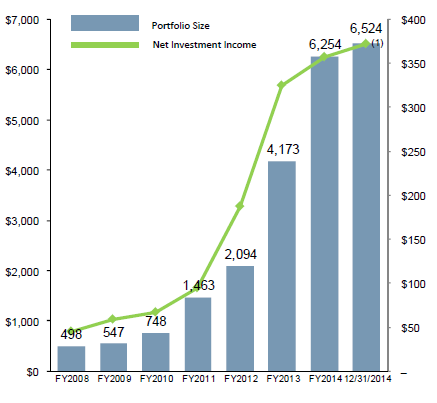Prospect Capital Corporation Earnings What to Watch
Post on: 14 Июнь, 2015 No Comment

- Article Comments (0)
Prospect Capital Corporation is coming out of a tough calendar year.
Last year brought a 25% dividend cut, a relatively large decrease in book value on a per-share basis, and some credit quality concerns emerging from writedowns and debt-for-equity swaps in controlled companies.
The fourth calendar quarter could be equally challenging. When Prospect Capital reports its fiscal second-quarter results (the fiscal quarter ended on Dec. 31, 2014), investors will want to pay attention to a few key portions of its portfolio.
Oil is the name of the game
Prospect Capital’s history runs deep in the oil business. It was primarily a lender to energy companies until the financial crisis, when it began an effort to lend and to invest in practically every industry under the sun. The company reported just 5.1% of direct energy exposure in a recent press release. However, true exposure runs deeper.
Many of its portfolio companies have exposure to oil and gas production, even if they are not oil companies themselves. United States Environmental Services, one of its portfolio companies, provides services to oil and gas producers and was written down in the prior quarter. It is not, however, included in the company’s previously reported 5.1% figure for energy exposure, as it is labeled as a commercial services company, not an energy company.
Prospect Capital’s collateralized loan obligation equity investments — CLO equity could be reasonably categorized as a leveraged bet on private loans — certainly have some oil exposure. How much exposure isn’t exactly clear. It labels them as CLO Investments in its industry concentration tables, which says nothing of the composition of assets inside the CLO.
Energy loans made up 4.5% and 4.1% of S&P’s and JPMorgan Chase ‘s loan indexes, respectively, according to the Financial Times. The same article suggests some CLOs could contain as much as 15% energy exposure. The average is probably closer to the amount of energy exposure in the broad indexes, however — probably less than 5%.
There is some give and take when oil prices come into play. Its consumer loan companies, namely First Tower and Credit Central, lend to subprime borrowers. Lower gas prices inevitably help consumers repay their debts. So where oil may negatively impact some investments, it should help others; how it balances out will be something to watch carefully. But given that Prospect Capital’s investments are primarily in the form of secured debt, not equity, the upside is generally much smaller than the downside.
Speaking of CLOs.
Prospect Capital sold four CLOs in the quarter, based on information obtained from its SEC filings. Three were sold at a loss, despite being carried at a premium to their fair value as of Sept. 30, 2014. (You’ll have to go back to its older filings to find this information; subsequent filings were changed to say that the CLOs were simply sold, not sold at a loss.)
Any changes to CLO equity valuations will be significant. At 18% of net asset value, a 10% reduction in average carrying values would result in a 3% haircut to net asset value — or roughly $0.31 per share — due to leverage.
At least one CLO dropped roughly 10% from its Sept. 30 carrying value to the time of its sale in the fourth calendar quarter. Similar movement in its CLOs that remain on balance sheet would hardly be unprecedented.
Spin-offs and the growing P2P loan book
The company intends to spin off its CLOs, real estate holdings, and peer-to-peer lending businesses. From its recent 497 filings. we learned that Prospect added $37 million to its peer-to-peer loan book in addition to a $28.2 million investment in small business whole loans, perhaps in an effort to bulk up on these assets before spinning them off.
The company’s plans for its spin-offs, even though such plans don’t necessarily affect quarterly earnings, need to be addressed. Since the company’s announcement, shares of online lender On Deck Capital. from which Prospect purchases its small business loans, have plummeted in value. Likewise, recent fluctuations in loan values may make its CLO spin-off marginally less attractive.
Remember, a key component to success of the spin-offs was the ability to raise new capital at the time the assets were spun off. Raising additional capital may be more difficult given the poor performance of On Deck Capital and CLO assets during the quarter. Falling interest rates may make its real estate assets a little more attractive, however.
A Foolish perspective
It’s almost certain that oil prices and volatility in the loan market (which affects its CLO values) will lead to unrealized losses and a declining book value this quarter. The question isn’t whether book value will rise or fall, but rather how much it will fall.
This quarter promises to be an interesting one. If there’s any consolation, it’s that Prospect Capital traded at a 21% discount to book value as of September. The market clearly doesn’t expect earth-shattering results. You probably shouldn’t, either.
Bank of America + Apple? This device makes it possible.
Apple recently recruited a secret-development dream team to guarantee its newest smart device was kept hidden from the public for as long as possible. But the secret is out. and some early viewers are claiming it’s destined to change everything from banking to healthcare. In fact, ABI Research predicts 485 million of this type of device will be sold per year. But one small company makes Apple’s gadget possible. And its stock price has nearly unlimited room to run for early, in-the-know investors. To be one of them, and see Apple’s newest smart gizmo, just click here !
Copyright © 1995 — 2015 The Motley Fool, LLC. All rights reserved. The Motley Fool has a disclosure policy .














